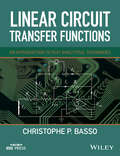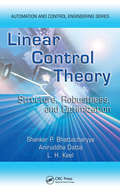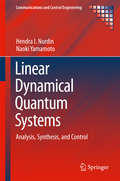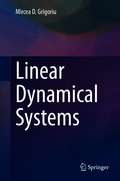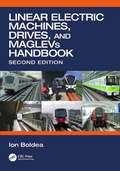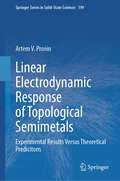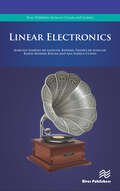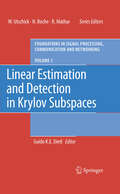- Table View
- List View
Linear Circuit Theory: Matrices in Computer Applications
by Jiri VlachThis comprehensive textbook covers all subjects on linear circuit theory, with the emphasis on learning the subject without an excessive amount of information. This unique approach stresses knowledge rather than computer use to start and differs from other books by introducing matrix algebra early in the book. The book's 290 problems are meant to b
Linear Circuit Transfer Functions: An Introduction to Fast Analytical Techniques (Wiley - IEEE)
by Christophe P. BassoLinear Circuit Transfer Functions: An introduction to Fast Analytical Techniques teaches readers how to determine transfer functions of linear passive and active circuits by applying Fast Analytical Circuits Techniques. Building on their existing knowledge of classical loop/nodal analysis, the book improves and expands their skills to unveil transfer functions in a swift and efficient manner. Starting with simple examples, the author explains step-by-step how expressing circuits time constants in different configurations leads to writing transfer functions in a compact and insightful way. By learning how to organize numerators and denominators in the fastest possible way, readers will speed-up analysis and predict the frequency response of simple to complex circuits. In some cases, they will be able to derive the final expression by inspection, without writing a line of algebra. Key features: Emphasizes analysis through employing time constant-based methods discussed in other text books but not widely used or explained. Develops current techniques on transfer functions, to fast analytical techniques leading to low-entropy transfer functions immediately exploitable for analysis purposes. Covers calculation techniques pertinent to different fields, electrical, electronics, signal processing etc. Describes how a technique is applied and demonstrates this through real design examples. All Mathcad® files used in examples and problems are freely available for download. An ideal reference for electronics or electrical engineering professionals as well as BSEE and MSEE students, this book will help teach them how to: become skilled in the art of determining transfer function by using less algebra and obtaining results in a more effectual way; gain insight into a circuit’s operation by understanding how time constants rule dynamic responses; apply Fast Analytical Techniques to simple and complicated circuits, passive or active and be more efficient at solving problems.
Linear Circuit Transfer Functions: An Introduction to Fast Analytical Techniques (Wiley - IEEE)
by Christophe P. BassoLinear Circuit Transfer Functions: An introduction to Fast Analytical Techniques teaches readers how to determine transfer functions of linear passive and active circuits by applying Fast Analytical Circuits Techniques. Building on their existing knowledge of classical loop/nodal analysis, the book improves and expands their skills to unveil transfer functions in a swift and efficient manner. Starting with simple examples, the author explains step-by-step how expressing circuits time constants in different configurations leads to writing transfer functions in a compact and insightful way. By learning how to organize numerators and denominators in the fastest possible way, readers will speed-up analysis and predict the frequency response of simple to complex circuits. In some cases, they will be able to derive the final expression by inspection, without writing a line of algebra. Key features: Emphasizes analysis through employing time constant-based methods discussed in other text books but not widely used or explained. Develops current techniques on transfer functions, to fast analytical techniques leading to low-entropy transfer functions immediately exploitable for analysis purposes. Covers calculation techniques pertinent to different fields, electrical, electronics, signal processing etc. Describes how a technique is applied and demonstrates this through real design examples. All Mathcad® files used in examples and problems are freely available for download. An ideal reference for electronics or electrical engineering professionals as well as BSEE and MSEE students, this book will help teach them how to: become skilled in the art of determining transfer function by using less algebra and obtaining results in a more effectual way; gain insight into a circuit’s operation by understanding how time constants rule dynamic responses; apply Fast Analytical Techniques to simple and complicated circuits, passive or active and be more efficient at solving problems.
Linear CMOS RF Power Amplifiers: A Complete Design Workflow
by Hector Solar Ruiz Roc Berenguer PérezThe work establishes the design flow for the optimization of linear CMOS power amplifiers from the first steps of the design to the final IC implementation and tests. The authors also focuses on design guidelines of the inductor’s geometrical characteristics for power applications and covers their measurement and characterization. Additionally, a model is proposed which would facilitate designs in terms of transistor sizing, required inductor quality factors or minimum supply voltage. The model considers limitations that CMOS processes can impose on implementation. The book also provides different techniques and architectures that allow for optimization.
Linear CMOS RF Power Amplifiers for Wireless Applications: Efficiency Enhancement and Frequency-Tunable Capability (Analog Circuits and Signal Processing)
by Paulo Augusto Dal Fabbro Maher KayalAdvances in electronics have pushed mankind to create devices, ranging from - credible gadgets to medical equipment to spacecraft instruments. More than that, modern society is getting used to—if not dependent on—the comfort, solutions, and astonishing amount of information brought by these devices. One ?eld that has continuously bene?tted from those advances is the radio frequency integrated c- cuit (RFIC) design, which in its turn has promoted countless bene?ts to the mankind as a payback. Wireless communications is one prominent example of what the - vances in electronics have enabled and their consequences to our daily life. How could anyone back in the eighties think of the possibilities opened by the wireless local area networks (WLANs) that can be found today in a host of places, such as public libraries, coffee shops, trains, to name just a few? How can a youngster, who lives this true WLAN experience nowadays, imagine a world without it? This book dealswith the design oflinearCMOS RF PowerAmpli?ers(PAs). The RF PA is a very important part of the RF transceiver, the device that enables wireless communications. Two important aspects that are key to keep the advances in RF PA design at an accelerate pace are treated: ef?ciency enhancement and frequen- tunable capability. For this purpose, the design of two different integrated circuits realizedina0. 11µmtechnologyispresented,eachoneaddressingadifferentaspect. With respect to ef?ciency enhancement, the design of a dynamic supply RF power ampli?er is treated, making up the material of Chaps. 2 to 4.
Linear Continuous-Time Systems
by Lyubomir T. GruyitchThis book aims to help the reader understand the linear continuous-time time-invariant dynamical systems theory and its importance for systems analysis and design of the systems operating in real conditions, i.e., in forced regimes under arbitrary initial conditions. The text completely covers IO, ISO and IIO systems. It introduces the concept of the system full matrix P(s) in the complex domain and establishes its link with the also newly introduced system full transfer function matrix F(s). The text establishes the full block diagram technique based on the use of F(s), which incorporates the Laplace transform of the input vector and the vector of all initial conditions. It explores the direct relationship between the system full transfer function matrix F(s) and the Lyapunov stability concept, definitions and conditions, as well as with the BI stability concept, definitions, and conditions. The goal of the book is to unify the study and applications of all three classes of the of the linear continuous-time time-invariant systems, for short systems.
Linear Continuous-Time Systems
by Lyubomir T. GruyitchThis book aims to help the reader understand the linear continuous-time time-invariant dynamical systems theory and its importance for systems analysis and design of the systems operating in real conditions, i.e., in forced regimes under arbitrary initial conditions. The text completely covers IO, ISO and IIO systems. It introduces the concept of the system full matrix P(s) in the complex domain and establishes its link with the also newly introduced system full transfer function matrix F(s). The text establishes the full block diagram technique based on the use of F(s), which incorporates the Laplace transform of the input vector and the vector of all initial conditions. It explores the direct relationship between the system full transfer function matrix F(s) and the Lyapunov stability concept, definitions and conditions, as well as with the BI stability concept, definitions, and conditions. The goal of the book is to unify the study and applications of all three classes of the of the linear continuous-time time-invariant systems, for short systems.
Linear Continuous-Time Systems
by Lyubomir T. GruyitchThis book aims to help the reader understand the linear continuous-time time-invariant dynamical systems theory and its importance for systems analysis and design of the systems operating in real conditions, i.e., in forced regimes under arbitrary initial conditions. The text completely covers IO, ISO and IIO systems. It introduces the concept of the system full matrix P(s) in the complex domain and establishes its link with the also newly introduced system full transfer function matrix F(s). The text establishes the full block diagram technique based on the use of F(s), which incorporates the Laplace transform of the input vector and the vector of all initial conditions. It explores the direct relationship between the system full transfer function matrix F(s) and the Lyapunov stability concept, definitions and conditions, as well as with the BI stability concept, definitions, and conditions. The goal of the book is to unify the study and applications of all three classes of the of the linear continuous-time time-invariant systems, for short systems.
Linear Control System Analysis and Design with MATLAB (Automation And Control Engineering Ser.)
by Constantine H. Houpis Stuart N. Sheldon John Joachim D'AzzoThoroughly classroom-tested and proven to be a valuable self-study companion, Linear Control System Analysis and Design: Sixth Edition provides an intensive overview of modern control theory and conventional control system design using in-depth explanations, diagrams, calculations, and tables. Keeping mathematics to a minimum, the book is designed
Linear Control Systems: With solved problems and MATLAB examples (University Series in Mathematics)
by Branislav Kisacanin Gyan C. AgarwalAnyone seeking a gentle introduction to the methods of modern control theory and engineering, written at the level of a first-year graduate course, should consider this book seriously. It contains: A generous historical overview of automatic control, from Ancient Greece to the 1970s, when this discipline matured into an essential field for electrical, mechanical, aerospace, chemical, and biomedical engineers, as well as mathematicians, and more recently, computer scientists; A balanced presentation of the relevant theory: the main state-space methods for description, analysis, and design of linear control systems are derived, without overwhelming theoretical arguments; Over 250 solved and exercise problems for both continuous- and discrete-time systems, often including MATLAB simulations; and Appendixes on MATLAB, advanced matrix theory, and the history of mathematical tools such as differential calculus, transform methods, and linear algebra. Another noteworthy feature is the frequent use of an inverted pendulum on a cart to illustrate the most important concepts of automatic control, such as: Linearization and discretization; Stability, controllability, and observability; State feedback, controller design, and optimal control; and Observer design, reduced order observers, and Kalman filtering. Most of the problems are given with solutions or MATLAB simulations. Whether the book is used as a textbook or as a self-study guide, the knowledge gained from it will be an excellent platform for students and practising engineers to explore further the recent developments and applications of control theory.
Linear Control Theory: Structure, Robustness, and Optimization (Automation and Control Engineering)
by Shankar P. Bhattacharyya Aniruddha Datta Lee H. KeelSuccessfully classroom-tested at the graduate level, Linear Control Theory: Structure, Robustness, and Optimization covers three major areas of control engineering (PID control, robust control, and optimal control). It provides balanced coverage of elegant mathematical theory and useful engineering-oriented results. The first part of the book develops results relating to the design of PID and first-order controllers for continuous and discrete-time linear systems with possible delays. The second section deals with the robust stability and performance of systems under parametric and unstructured uncertainty. This section describes several elegant and sharp results, such as Kharitonov’s theorem and its extensions, the edge theorem, and the mapping theorem. Focusing on the optimal control of linear systems, the third part discusses the standard theories of the linear quadratic regulator, Hinfinity and l1 optimal control, and associated results. Written by recognized leaders in the field, this book explains how control theory can be applied to the design of real-world systems. It shows that the techniques of three term controllers, along with the results on robust and optimal control, are invaluable to developing and solving research problems in many areas of engineering.
Linear Control Theory: Structure, Robustness, and Optimization (Automation and Control Engineering)
by Shankar P. Bhattacharyya Aniruddha Datta Lee H. KeelSuccessfully classroom-tested at the graduate level, Linear Control Theory: Structure, Robustness, and Optimization covers three major areas of control engineering (PID control, robust control, and optimal control). It provides balanced coverage of elegant mathematical theory and useful engineering-oriented results. The first part of the book develops results relating to the design of PID and first-order controllers for continuous and discrete-time linear systems with possible delays. The second section deals with the robust stability and performance of systems under parametric and unstructured uncertainty. This section describes several elegant and sharp results, such as Kharitonov’s theorem and its extensions, the edge theorem, and the mapping theorem. Focusing on the optimal control of linear systems, the third part discusses the standard theories of the linear quadratic regulator, Hinfinity and l1 optimal control, and associated results. Written by recognized leaders in the field, this book explains how control theory can be applied to the design of real-world systems. It shows that the techniques of three term controllers, along with the results on robust and optimal control, are invaluable to developing and solving research problems in many areas of engineering.
Linear Discrete-Time Systems
by Zoran M. Buchevats Lyubomir T. GruyitchThis book covers crucial lacunae of the linear discrete-time time-invariant dynamical systems and introduces the reader to their treatment, while functioning under real, natural conditions, in forced regimes with arbitrary initial conditions. It provides novel theoretical tools necessary for the analysis and design of the systems operating in stated conditions. The text completely covers two well-known systems, IO and ISO, along with a new system, IIO. It discovers the concept of the full transfer function matrix F(z) in the z-complex domain, which incorporates the Z-transform of the system, input and another variable, vectors, all with arbitrary initial conditions. Consequently, it addresses the full system matrix P(z) and the full block diagram technique based on the use of F(z), which incorporates the Z-transform of the system, input and another variable, vectors, all with arbitrary initial conditions. The book explores the direct relationship between the system full transfer function matrix F(z) and the Lyapunov stability concept, definitions, and conditions, as well as with the BI stability concept, definitions, and conditions. The goal of the book is to unify the study and applications of all three classes of the linear discrete-time time-invariant system, for short systems.
Linear Dynamical Quantum Systems: Analysis, Synthesis, and Control (Communications and Control Engineering)
by Hendra I Nurdin Naoki YamamotoThis monograph provides an in-depth treatment of the class of linear-dynamical quantum systems. The monograph presents a detailed account of the mathematical modeling of these systems using linear algebra and quantum stochastic calculus as the main tools for a treatment that emphasizes a system-theoretic point of view and the control-theoretic formulations of quantum versions of familiar problems from the classical (non-quantum) setting, including estimation and filtering, realization theory, and feedback control. Both measurement-based feedback control (i.e., feedback control by a classical system involving a continuous-time measurement process) and coherent feedback control (i.e., feedback control by another quantum system without the intervention of any measurements in the feedback loop) are treated. Researchers and graduates studying systems and control theory, quantum probability and stochastics or stochastic control whether from backgrounds in mechanical or electrical engineering or applied mathematics will find this book to be a valuable treatment of the control of an important class of quantum systems. The material presented here will also interest physicists working in optics, quantum optics, quantum information theory and other quantum-physical disciplines.
Linear Dynamical Systems
by Mircea D. GrigoriuThis textbook provides a concise, clear, and rigorous presentation of the dynamics of linear systems that delivers the necessary tools for the analysis and design of mechanical/ structural systems, regardless of their complexity. The book is written for senior undergraduate and first year graduate students as well as engineers working on the design of mechanical/structural systems subjected to dynamic actions, such as wind/earthquake engineers and mechanical engineers working on wind turbines. Professor Grigoriu's lucid presentation maximizes student understanding of the formulation and the solution of linear systems subjected to dynamic actions, and provides a clear distinction between problems of practical interest and their special cases. Based on the author's lecture notes from courses taught at Cornell University, the material is class-tested over many years and ideal as a core text for a range of classes in mechanical, civil, and geotechnical engineering, as well as for self-directed learning by practitioners in the field.
Linear Elasticity of Elastic Circular Inclusions Part 2/Lineare Elastizitätstheorie bei kreisrunden elastischen Einschlüssen Teil 2 (SpringerBriefs in Applied Sciences and Technology)
by Thomas RanzIn this book the real analytic solutions for the “Disc with Circular Inclusion” under normal- and shear force at plane-strain state (EVZ) are presented. The associated solution process, which was developed according to the principle of statically indeterminate systems, is documented extensively. The solutions are given in terms of mechanical quantities (deformations, strains and stresses). Due to the superposition of the solutions for normal force in x- and y-direction and shear force the plane strain-stress relation can be formulated. The validation of the real analytic solutions is carried out by numeric FEM solution results. Comparing the results of the finite and infinite disc there is, however, a very high correspondence of all mechanical quantities. Therefore it can be assumed the real analytical solutions are the exact solutions.
Linear Elasticity of Elastic Circular Inclusions Part 2/Lineare Elastizitätstheorie bei kreisrunden elastischen Einschlüssen Teil 2 (SpringerBriefs in Applied Sciences and Technology)
by Thomas RanzThis revised, new edition presents the real analytic solutions for the “Disc with Circular Inclusion” under normal- and shear force at plane-strain state. The associated solution process, which was developed according to the principle of statically indeterminate systems, is documented extensively. The solutions are given in terms of mechanical quantities (deformations, strains and stresses). Due to the superposition of the solutions for normal force in x- and y-direction and shear force the plane strain-stress relation can be formulated. The validation of the real analytic solutions is carried out by numeric FEM solution results. Comparing the results of the finite and infinite disc there is, however, a very high correspondence of all mechanical quantities. Therefore it can be assumed the real analytical solutions are the exact solutions.
Linear Electric Machines, Drives, and MAGLEVs Handbook
by Ion BoldeaLinear motion is richly present in various industries, from direct electric propulsion in urban and interurban people movers on wheels or on magnetic “cushions” (MAGLEVs) to indoor transport of goods (conveyors, etc.), through plunger solenoids (to open hotel doors and as electromagnetic power switches), to compressor drives by linear oscillatory permanent magnet (PM) motors, smart phones integrated microphone and loudspeakers, and controlled vehicles’ suspension, etc. Besides the traditional rotary motor drives with mechanical transmissions, which mean friction limitations (weather dependent) in traction (heavy vehicles), more losses, positioning errors (backlash) in the process, and higher maintenance costs to handle them, linear motion in industry by direct electromagnetic forces is free of friction limitations for traction, free of mechanical transmission, and thus more efficient, with less maintenance cost and fewer positioning errors (backlash). This explains why they are used in so many applications already since the dramatic advancement of power electronics and digital control in the last four decades.Modeling, performance, design, control, and testing of linear electric machines (LEMs) show notable differences with respect to rotary electric motor drives, which warrant a dedicated treatment of these aspects.The Second Edition (First Edition: 2013) concentrates on the above technical aspects of various types of LEMs in close relationship with specific applications via numerical examples of modeling, design, control, and testing, with ample representative results from literature, industry and some of the author’s contributions, such as: Technical field and circuit modeling of linear induction motors in flat configurations for low and high speeds (with and without dynamic end effects) and in tubular configurations short travel design, control and testing Linear synchronous motor (LSM) drives in dc-excited, homopolar, reluctance and superconducting excitation configurations for urban and interurban high-speed vehicles propulsion and integrated propulsion and levitation (in MAGLEVs) modeling, design and control with full-scale numerical examples, with emphasis on lower KWh/passenger/Km at high speeds Flat and tubular linear permanent magnet (PM) synchronous motors (L-PMSMs), mainly destined to industrial indoor transport for automation at high efficiency in clean rooms Linear “flux-modulation” motors— new breed, suitable for very low-speed applications due to higher thrust density Plunger solenoids in various applications including new valve PM actuators with millisecond response time Linear resonant PM oscillatory motors design, control and testing mainly destined to compressors for higher efficiency in compact drives Attraction and repulsive force suspension (levitation) systems for MAGLEVs Active and passive guideway MAGLEVs in urban and superhigh-speed interurban transport at lower Kwh per passenger/km (in lighter vehicles without wheels) The numerous numerical design and control examples (with practical specifications) throughout the 23 chapters of the book allow the reader deep and fast access to a practical but thorough unitary (good for comparisons) methodology in designing and controlling LEMs for various applications.
Linear Electric Machines, Drives, and MAGLEVs Handbook
by Ion BoldeaLinear motion is richly present in various industries, from direct electric propulsion in urban and interurban people movers on wheels or on magnetic “cushions” (MAGLEVs) to indoor transport of goods (conveyors, etc.), through plunger solenoids (to open hotel doors and as electromagnetic power switches), to compressor drives by linear oscillatory permanent magnet (PM) motors, smart phones integrated microphone and loudspeakers, and controlled vehicles’ suspension, etc. Besides the traditional rotary motor drives with mechanical transmissions, which mean friction limitations (weather dependent) in traction (heavy vehicles), more losses, positioning errors (backlash) in the process, and higher maintenance costs to handle them, linear motion in industry by direct electromagnetic forces is free of friction limitations for traction, free of mechanical transmission, and thus more efficient, with less maintenance cost and fewer positioning errors (backlash). This explains why they are used in so many applications already since the dramatic advancement of power electronics and digital control in the last four decades.Modeling, performance, design, control, and testing of linear electric machines (LEMs) show notable differences with respect to rotary electric motor drives, which warrant a dedicated treatment of these aspects.The Second Edition (First Edition: 2013) concentrates on the above technical aspects of various types of LEMs in close relationship with specific applications via numerical examples of modeling, design, control, and testing, with ample representative results from literature, industry and some of the author’s contributions, such as: Technical field and circuit modeling of linear induction motors in flat configurations for low and high speeds (with and without dynamic end effects) and in tubular configurations short travel design, control and testing Linear synchronous motor (LSM) drives in dc-excited, homopolar, reluctance and superconducting excitation configurations for urban and interurban high-speed vehicles propulsion and integrated propulsion and levitation (in MAGLEVs) modeling, design and control with full-scale numerical examples, with emphasis on lower KWh/passenger/Km at high speeds Flat and tubular linear permanent magnet (PM) synchronous motors (L-PMSMs), mainly destined to industrial indoor transport for automation at high efficiency in clean rooms Linear “flux-modulation” motors— new breed, suitable for very low-speed applications due to higher thrust density Plunger solenoids in various applications including new valve PM actuators with millisecond response time Linear resonant PM oscillatory motors design, control and testing mainly destined to compressors for higher efficiency in compact drives Attraction and repulsive force suspension (levitation) systems for MAGLEVs Active and passive guideway MAGLEVs in urban and superhigh-speed interurban transport at lower Kwh per passenger/km (in lighter vehicles without wheels) The numerous numerical design and control examples (with practical specifications) throughout the 23 chapters of the book allow the reader deep and fast access to a practical but thorough unitary (good for comparisons) methodology in designing and controlling LEMs for various applications.
Linear Electrodynamic Response of Topological Semimetals: Experimental Results Versus Theoretical Predicitons (Springer Series in Solid-State Sciences #199)
by Artem V. ProninThis book provides a model description for the electromagnetic response of topological nodal semimetals and summarizes recent experimental findings in these systems. Specifically, it discusses various types of topological semimetals – Dirac, Weyl, nodal-line, triple-point, and multifold semimetals – and provides description for the characteristic features of the linear electrodynamic response for all these types of materials.Topological semimetals possess peculiar bulk electronic band structure, which leads to unusual electrodynamic response. For example, the low-energy inter-band optical conductivity of nodal semimetals is supposed to demonstrate power-law frequency dependence and the intra- and inter-band contributions to the conductivity are often mixed. Further, the magneto-optical response is also unusual, because of the non-equidistant spacing between the Landau levels. Finally, in semimetals with chiral electronic bands, e.g. in Weyl semimetals, the simultaneous application of parallel magnetic and electric fields leads to the chiral anomaly, i.e. to a misbalance between the electrons with diffident chiralities. This misbalance affects the electrodynamics properties of the material and can be detected optically. All these points are addressed here in detail.The book is written for a wide audience of physicists, working in the field of topological condensed matter physics. It gives a pedagogical introduction enabling graduate students and non-experts to familiarize themselves with the subject.
Linear Electronics
by Marcelo Sampaio Alencar Raphael Tavares Alencar Raissa Bezerra Rocha Ana Isabela CunhaA considerable amount of effort has been devoted, both in industry and academia, towards the design, performance, analysis and evaluation of amplification schemes and filters to be used in control systems, audio/video equipment, instrumentation and communication systems.This book is intended to serve as a complementary textbook for courses dealing with Linear Amplification, but also as a professional book, for engineers who need to update their knowledge in the electronics, control, and communications areas.The book is suitable for the undergraduate as well as the initial graduate levels of Electrical Engineering courses and is useful for the professional who wants to review or get acquainted with amplification theory. The book presents essential concepts in plain language and covers the most important applications of amplifier circuits. The book has four appendices, an appendix to detail the operational amplifier model, an appendix with specification data sheets, an appendix on Fourier transform and signal spectrum, including the concepts of convolution, autocorrelation and power spectral density, for deterministic signals, and a final one that presents and explains the usual electronics acronyms.
Linear Electronics
by Marcelo Sampaio Alencar Raphael Tavares Alencar Raissa Bezerra Rocha Ana Isabela CunhaA considerable amount of effort has been devoted, both in industry and academia, towards the design, performance, analysis and evaluation of amplification schemes and filters to be used in control systems, audio/video equipment, instrumentation and communication systems.This book is intended to serve as a complementary textbook for courses dealing with Linear Amplification, but also as a professional book, for engineers who need to update their knowledge in the electronics, control, and communications areas.The book is suitable for the undergraduate as well as the initial graduate levels of Electrical Engineering courses and is useful for the professional who wants to review or get acquainted with amplification theory. The book presents essential concepts in plain language and covers the most important applications of amplifier circuits. The book has four appendices, an appendix to detail the operational amplifier model, an appendix with specification data sheets, an appendix on Fourier transform and signal spectrum, including the concepts of convolution, autocorrelation and power spectral density, for deterministic signals, and a final one that presents and explains the usual electronics acronyms.
Linear Electrooptic Modular Materials
by J. T. MilekThis survey of 13 electrooptic materials includes both a review and compilation of all materials properties relevant to their use in linear (Pockels) electrooptic modulator applications. Information on actual electrooptic modulator design as well as applications for these materials, and data on materials exhibiting a quadratic (Kerr) electrooptic effect, are not included. With these restrictions in mind, every attempt was made to be as comprehensive as possible by utilizing all available sources of literature: books, periodicals, reports, and vendor literature. The files of the Electronic Properties Information Center and full resources of the Hughes Aircraft Company Library were searched for pertinent data, and approximately 1000 articles were reviewed for this pUblication. A brief Introduction to the survey is followed by a description of the Prin ciples of Electrooptic Modulation, emphasizing the importance of crystal symmetry on the electrooptic properties of materials, and including the relationships between the electrooptic, piezooptic, elastooptic and piezoelectric effects in crystals. The survey consists of 13 independent sections, each section covering the properties of one material: crystallographic, optical, electrooptic, photoelastic, piezoelectric, dielectric and thermal. References appearing in the text are listed at the conclusion of each section. Tables and Figures are numbered separately for each section. v TABLE OF CONTENTS INTRODUCTION . • . . . . . 1 PRINCIPLES OF ELECTROOPTIC MODULATION. 5 AMMONIUM DIHYDROGEN ARSENATE (ADA) . 15 AMMONIUM DIHYDROGEN PHOSPHATE (ADP).
Linear Estimation and Detection in Krylov Subspaces (Foundations in Signal Processing, Communications and Networking #1)
by Guido K. DietlThis book focuses linear estimation theory, which is essential for effective signal processing. The first section offers a comprehensive overview of key methods like reduced-rank signal processing and Krylov subspace methods of numerical mathematics. Also, the relationship between statistical signal processing and numerical mathematics is presented. In the second part, the theory is applied to iterative multiuser detection receivers (Turbo equalization) which are typically desired in wireless communications systems.

